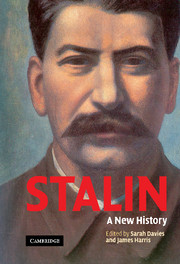Book contents
- Frontmatter
- Contents
- Notes on contributors
- Preface
- A note on transliteration
- Glossary
- 1 Joseph Stalin: power and ideas
- 2 Stalin as Georgian: the formative years
- 3 Stalin as Commissar for Nationality Affairs, 1918–1922
- 4 Stalin as General Secretary: the appointments process and the nature of Stalin's power
- 5 Stalin as Prime Minister: power and the Politburo
- 6 Stalin as dictator: the personalisation of power
- 7 Stalin as economic policy-maker: Soviet agriculture, 1931–1936
- 8 Stalin as foreign policy-maker: avoiding war, 1927–1953
- 9 Stalin as Marxist: the Western roots of Stalin's russification of Marxism
- 10 Stalin as Bolshevik romantic: ideology and mobilisation, 1917–1939
- 11 Stalin as patron of cinema: creating Soviet mass culture, 1932–1936
- 12 Stalin as producer: the Moscow show trials and the construction of mortal threats
- 13 Stalin as symbol: a case study of the personality cult and its construction
- 14 Stalin as the coryphaeus of science: ideology and knowledge in the post-war years
- Index
6 - Stalin as dictator: the personalisation of power
Published online by Cambridge University Press: 24 November 2009
- Frontmatter
- Contents
- Notes on contributors
- Preface
- A note on transliteration
- Glossary
- 1 Joseph Stalin: power and ideas
- 2 Stalin as Georgian: the formative years
- 3 Stalin as Commissar for Nationality Affairs, 1918–1922
- 4 Stalin as General Secretary: the appointments process and the nature of Stalin's power
- 5 Stalin as Prime Minister: power and the Politburo
- 6 Stalin as dictator: the personalisation of power
- 7 Stalin as economic policy-maker: Soviet agriculture, 1931–1936
- 8 Stalin as foreign policy-maker: avoiding war, 1927–1953
- 9 Stalin as Marxist: the Western roots of Stalin's russification of Marxism
- 10 Stalin as Bolshevik romantic: ideology and mobilisation, 1917–1939
- 11 Stalin as patron of cinema: creating Soviet mass culture, 1932–1936
- 12 Stalin as producer: the Moscow show trials and the construction of mortal threats
- 13 Stalin as symbol: a case study of the personality cult and its construction
- 14 Stalin as the coryphaeus of science: ideology and knowledge in the post-war years
- Index
Summary
Though the ‘personal factor’ in Soviet history has been debated countless times, it should surprise no one that key events and even entire stages are associated with individuals, such as Lenin with NEP, Stalin with the Great Break, Khrushchev with the Thaw, Gorbachev with Perestroika. Though these are conventions and imprecise references, they reflect an obvious fact: Soviet leaders (like leaders of other countries) had a substantial influence on the course of events. What is at issue is just how strong that influence was, what were its mechanisms, what role was played by this or that leader to cause a period or event to be named after him.
Research on the role of Stalin in the Stalinist dictatorship has provoked widely divergent views. On the one hand, the totalitarian model proceeded from the assumption that Stalin was the lynchpin of the system, and that it would collapse without him. On the other hand, some historians for various reasons have expressed doubts about the strength of Stalin's power and have even written about a loss of real power in certain periods (a peculiar version of the theory of the ‘weak dictator’). However, the majority of historians writing abut Stalin and Stalinism prefer to work with actual documents, thanks to which substantial material has been accumulated and important observations made. This tradition of careful work with sources has played the biggest role in the last ten years since the archives were opened.
- Type
- Chapter
- Information
- StalinA New History, pp. 108 - 120Publisher: Cambridge University PressPrint publication year: 2005
- 1
- Cited by

